|
|
|
Sort Order |
|
|
|
Items / Page
|
|
|
|
|
|
|
| Srl | Item |
| 1 |
ID:
127786
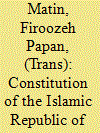

|
|
|
|
|
| Publication |
2014.
|
| Summary/Abstract |
On 3 December 1979, almost one year after Mohammad Reza Shah Pahlavi left Iran, the Constitution of the Islamic Republic of Iran replaced the monarchical constitution of 1906. The new constitution was to guarantee that the monarchy was abolished and the Islamic Republic system of government was enforced in its place. The constitution was to observe the Islamic and the nationalistic aims of the revolution with regard to the demands of a public that came from various social, religious, ethnic, and political backgrounds. Thus the 1979 constitution included differing components, which necessitated the amendments and the modifications that were added to the constitution in 1989. The constitution and its development are subjects that have been discussed in detail by scholars of modern Iran, among whom Asghar Schirazi stands out for his comprehensive study of the constitution. The following translation of the Constitution of the Islamic Republic of Iran highlights the relationship between the 1979 text of the constitution and the 1989 amendments in an attempt to contribute to the ongoing discussions on this subject.
|
|
|
|
|
|
|
|
|
|
|
|
|
|
|
|
| 2 |
ID:
005160
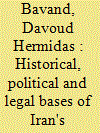

|
|
|
|
|
| Publication |
New York, Internet Concepts Inc., 1994.
|
| Description |
128p.pbk
|
| Standard Number |
0964310600
|
|
|
|
|
|
|
|
|
|
|
|
Copies: C:1/I:0,R:0,Q:0
Circulation
| Accession# | Call# | Current Location | Status | Policy | Location |
| 036344 | 955/BAV 036344 | Main | On Shelf | General | |
|
|
|
|
| 3 |
ID:
127782
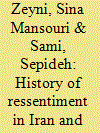

|
|
|
|
|
| Publication |
2014.
|
| Summary/Abstract |
Two dichotomies, one that resents the West and another that admires it, seem to have long polarized both Iranian intellectuals and the public imagination. Darioush Ashouri discusses this issue in terms of "ressentiment," a term he borrows from Nietzsche. This study puts Ashouri's scattered views within a Nietzschean framework to form a coherent theory, and places it against the background of a brief history of ressentiment in Iran. It then argues that signs of a ressentiment-less young generation, mostly university students, seem to be appearing, and a certain kind of social behavior on Facebook and a work by the Iranian musician Mohsen Namjoo are analyzed as evidence of this emerging mindset.
|
|
|
|
|
|
|
|
|
|
|
|
|
|
|
|
| 4 |
ID:
128995
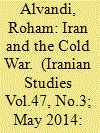

|
|
|
|
|
| Publication |
2014.
|
| Summary/Abstract |
For five decades, fromthe 1940s to the 1980s, Iran lived in the shadow of the Cold War between the United States and the Soviet Union. The country's geography, bordering both the USSR and the oil-rich Persian Gulf, meant that its territory and natural resources were of vital strategic importance in the ideological and material contest between the two superpowers, a global struggle over nothing less than "the soul of mankind."1 With the passage of nearly seventy years since the first Soviet-American confrontation in northern Iran, a growing number of scholars are examining the history of Iran's ColdWar, especially during the reign of Mohammad Reza Shah Pahlavi. Building on the work of earlier diplomatic historians, this emerging historiography looks both inward, at the impact of the Cold War on Iran, and outward, at the role of Iran in the Cold War far beyond its borders.2 This special issue showcases examples of this recent work by historians of Iran's Cold War, some of which was presented at the 2012 biannual conference of the International Society for Iranian Studies in Istanbul. Iran's importance in the Cold War is reflected in the rich literature on Iran's international history during the late Pahlavi period. The 1946 Iranian crisis marked the beginning of Iran's Cold War and the origins of the alliance between the United States and Iran, which continued until the fall of Mohammad Reza Shah in 1979.
|
|
|
|
|
|
|
|
|
|
|
|
|
|
|
|
| 5 |
ID:
001019
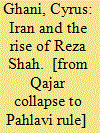

|
|
|
|
|
| Publication |
London, I B Tauris, 1998.
|
| Description |
xiv, 434p.hbk
|
| Standard Number |
1860642586
|
|
|
|
|
|
|
|
|
|
|
|
Copies: C:1/I:0,R:0,Q:0
Circulation
| Accession# | Call# | Current Location | Status | Policy | Location |
| 040540 | 955.052/GHA 040540 | Main | On Shelf | General | |
|
|
|
|
| 6 |
ID:
046706


|
|
|
|
|
| Publication |
Washington,DC, The Washington Institute for Near East Policy, 1998.
|
| Description |
viii, 114p.pbk
|
| Contents |
A Washington Institute Monograph
|
| Standard Number |
0944029272
|
|
|
|
|
|
|
|
|
|
|
|
Copies: C:1/I:0,R:0,Q:0
Circulation
| Accession# | Call# | Current Location | Status | Policy | Location |
| 045783 | 955.0543/CLA 045783 | Main | On Shelf | General | |
|
|
|
|
| 7 |
ID:
127784
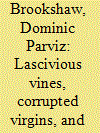

|
|
|
|
|
| Publication |
2014.
|
| Summary/Abstract |
The Persian wine production myth centers on the relationship between a male vintner and his female vine and her daughters, the grapes. This myth, the earliest extant examples of which are found in qas?das by the Samanid poets R?dak? and Bashsh?r Marghaz? and which was much developed by Man?chihr? and his contemporary Farrukh?, contains images of femininity, the mother-child bond, separation, violence, execution, and ultimate redemption. The grape harvest comes in the late summer and culminates in the Mihrag?n festival, a celebration focused on the grape and grape wine, at which poems containing versions of the wine production myth were recited. The present study maps the evolution of this myth over the span of a century through a close reading of eleven poems with specific reference to variations in narrative structure.
|
|
|
|
|
|
|
|
|
|
|
|
|
|
|
|
| 8 |
ID:
000572
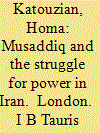

|
|
|
|
|
| Publication |
London, I B Tauris Publishers, 1999.
|
| Description |
xxv, 304p.pbk
|
| Standard Number |
1860642901
|
|
|
|
|
|
|
|
|
|
|
|
Copies: C:1/I:0,R:0,Q:0
Circulation
| Accession# | Call# | Current Location | Status | Policy | Location |
| 041930 | 923.255/KAT 041930 | Main | On Shelf | General | |
|
|
|
|
| 9 |
ID:
129001
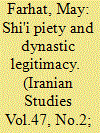

|
|
|
|
|
| Publication |
2014.
|
| Summary/Abstract |
Mashhad, the site in northeastern Iran of the shrine of the eighth Shi?i imam, is arguably one of the largest and wealthiest sacred shrines in the world. The gilded dome over the imam's mausoleum stands amidst an expansive complex of courts, monumental gateways, libraries, museums, guesthouses, and administrative offices that cater to thousands of pilgrims each year. This paper examines the period, under the aegis of the early Safavid shahs, when Mashhad was established as the preeminent Shi?i pilgrimage center in Iran. Appropriating the Timurid ecumenical vision for the shrine, the Safavid shahs refashioned the holy city into a site that celebrated the triumph of Twelver Shi?ism in the Safavid realm and reinforced Safavid claims of legitimacy. While highlighting Shah Tahmasb's personal devotion to Mashhad, and his privileging of the shrine within Safavid sacred topography, the paper focuses on Shah ?Abbas's urban reshaping of Mashhad and the architectural and institutional expansion of the shrine during his reign, thereby enhancing its status as the leading spiritual center in the Safavid empire.
|
|
|
|
|
|
|
|
|
|
|
|
|
|
|
|
| 10 |
ID:
094202


|
|
|
|
|
| Publication |
New York, Palgrave Macmillan, 2009.
|
| Description |
xvii, 247p.
|
| Standard Number |
9780230616783
|
|
|
|
|
|
|
|
|
|
|
|
Copies: C:1/I:0,R:0,Q:0
Circulation
| Accession# | Call# | Current Location | Status | Policy | Location |
| 054829 | 955/POL 054829 | Main | On Shelf | General | |
|
|
|
|
| 11 |
ID:
127785
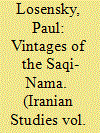

|
|
|
|
|
| Publication |
2014.
|
| Summary/Abstract |
Drawing on a rich tradition of anacreontic poetry and taking inspiration from works by Niz?m? and H?fiz, the s?q?-n?ma or "cupbearer's song" emerged as an independent genre in the early sixteenth century and flourished throughout the Persian literary world for the next 250 years. Looking back on the development of the genre, the early seventeenth-century literary historians 'Abd al-Nab? Qazv?n? and Awhad? Baly?n? give contrasting accounts of its formation, but both agree on the significance of the work of Hak?m Partuv? Sh?r?z? (d. 928/1520-21). An examination of his s?q?-n?ma, together with two other early representatives of the genre by Sidq? Astar?b?d? (d. 952/1545) and Sharaf Jah?n Qazv?n? (d. 968/1561), shows how closely this new genre was tied to the politics and ideology of the new Safavid state and reveals profound structural similarities to the preeminent panegyric genre of the Islamicate world, the qas?da. But once the basic components of the s?q?-n?m? were distilled and taken up by poets outside this socio-political environment, the genre proved to be as protean as the wine symbolism at its core. Cupbearer songs from the end of the century, particularly those of Muhammad S?f? M?zandar?n? (d. 1035/1625-26) and Sanjar K?sh?n? (d. 1021/1612), show how the basic elements of the genre could be reconfigured to serve a variety of more personal interests.
|
|
|
|
|
|
|
|
|
|
|
|
|
|
|
|
|
|
|
|
|